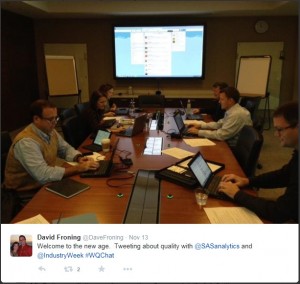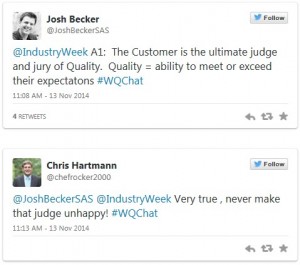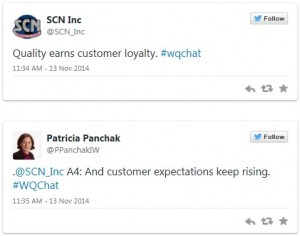Try as we might, we aren’t ubiquitous creatures. When you can’t be everywhere at once, there is usually data somewhere to fall back on. So you review that data, gain insights. If you’re smart, you take notice those insights, evolve and then forecast what’s next. (That’s analytics by the way.)  In case you didn’t make our SAS and IndustryWeek-sponsored Twitter chat on quality, join me for a few highlights.
In case you didn’t make our SAS and IndustryWeek-sponsored Twitter chat on quality, join me for a few highlights.
With a set of pre-determined questions and a collaborative effort between industry and independent thought leaders, manufacturing customers and SAS experts, the conversation around quality was lively. If a 140-character limit responses were difficult for our participants, you sure wouldn’t know it.
Starting out with definitions of quality, there were a wide range of responses from traditional to more modern insights. What was once product-focused and intended to be a measure of excellence, quality now resides more in the realm of total experience, from research of a purchase to service after the sale.
 Amid the stream of commentary was an overarching theme became apparent, a foundational concept for quality that’s been around for decades thanks to methodologies of Six Sigma:
Amid the stream of commentary was an overarching theme became apparent, a foundational concept for quality that’s been around for decades thanks to methodologies of Six Sigma:
voice of the customer, or VOC.
There were more than 30 mentions of the customer during our hour-long quality chat. And for good reason, too.  Building a customer relationship will help improve quality. With the ability to be heard through social media, the customer has immense power to make or break a brand. Rather than simply accepting product claims or promotional information, the customer researches reviews, blogs and social networks to make purchasing decisions.
Building a customer relationship will help improve quality. With the ability to be heard through social media, the customer has immense power to make or break a brand. Rather than simply accepting product claims or promotional information, the customer researches reviews, blogs and social networks to make purchasing decisions.
Quality is about perception
as much as it’s about specifications.
The chat continued with talk about the evolving landscape for quality with the industrial Internet, sensor data, the Internet of Things (IoT) and smart manufacturing.  Again, the link with the customer was clear.
Again, the link with the customer was clear.
A connected network strengthens the relationship with the customer. The ability to capture data, manage and predict what happens offers a new level of quality and reliability that the customer expects from innovative brands. It’s the future of quality, and it’s already taking hold.
So what’s the takeaway, other than your Scrabble game could use quality letter tiles to win? It's simple:
It continually involves and improves. Expectations are high and only goes up from here. Manufacturers must maintain focus on quality, in all its many facets.
.
The conversation will continue, maybe even again on Twitter. In the meantime, I'd love to get your take on this topic.

